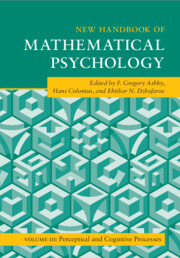Book contents
- Frontmatter
- Contents
- Contributors
- Preface
- 1 Principles and Consequences of the Initial Visual Encoding
- 2 Measuring Multisensory Integration in Selected Paradigms
- 3 Fechnerian Scaling: Dissimilarity Cumulation Theory
- 4 Mathematical Models of Human Learning
- 5 Formal Models of Memory Based on Temporally-Varying Representations
- 6 Statistical Decision Theory
- 7 Modeling Response Inhibition in the Stop-Signal Task
- 8 Approximate Bayesian Computation
- 9 Cognitive Diagnosis Models
- 10 Encoding Models in Neuroimaging
- Index
6 - Statistical Decision Theory
Published online by Cambridge University Press: 20 April 2023
- Frontmatter
- Contents
- Contributors
- Preface
- 1 Principles and Consequences of the Initial Visual Encoding
- 2 Measuring Multisensory Integration in Selected Paradigms
- 3 Fechnerian Scaling: Dissimilarity Cumulation Theory
- 4 Mathematical Models of Human Learning
- 5 Formal Models of Memory Based on Temporally-Varying Representations
- 6 Statistical Decision Theory
- 7 Modeling Response Inhibition in the Stop-Signal Task
- 8 Approximate Bayesian Computation
- 9 Cognitive Diagnosis Models
- 10 Encoding Models in Neuroimaging
- Index
Summary
Statistical decision theory provides a general account of perceptual decision-making in a wide variety of tasks that range from simple target detection to complete identification. The fundamental assumptions are that all sensory representations are inherently noisy and that every behavior, no matter how trivial, requires a decision. Statistical decision theory is referred to as signal detection theory (SDT) when the stimuli vary on only one sensory dimension, and general recognition theory (GRT) when the stimuli vary on two or more sensory dimensions. SDT and GRT are both reviewed. The SDT review focuses on applications to the two-stimulus identification task and multiple-look experiments, and on response-time extensions of the model (e.g., the drift-diffusion model). The GRT review focuses on applications to identification and categorization experiments, and in the former case, especially on experiments in which the stimuli are constructed by factorially combining several levels of two stimulus dimensions. The basic GRT properties of perceptual separability, decisional separability, perceptual independence, and holism are described. In the case of identification experiments, the summary statistics method for testing perceptual interactions is described, and so is the model-fitting approach. Response time and neuroscience extensions of GRT are reviewed.
Keywords
Information
- Type
- Chapter
- Information
- New Handbook of Mathematical Psychology , pp. 265 - 310Publisher: Cambridge University PressPrint publication year: 2023
